IKEA: Business Environment Analysis and Organizational Functions
VerifiedAdded on 2020/07/23
|17
|5069
|229
Report
AI Summary
This report provides a comprehensive analysis of IKEA's business environment. It begins by examining different types of organizations including private, public, and voluntary sectors, and their respective legal structures, with specific examples of IKEA, Sainsbury, and Wellcome Trust. The report then explores the size and scope of these organizations. Furthermore, it delves into the relationship between various organizational functions, such as human resource management, marketing, and finance, and how these functions are interlinked to achieve business objectives. The report also includes an internal and external analysis of IKEA, evaluating the positive and negative impacts of the macro environment on its operations. The study highlights the interrelation of strengths and weaknesses with external macro factors. The study also discusses the size and scope of different types of organization and the relationship between organizational functions and their linkage with objectives and structure. The report concludes with an assessment of IKEA's business environment and operations.
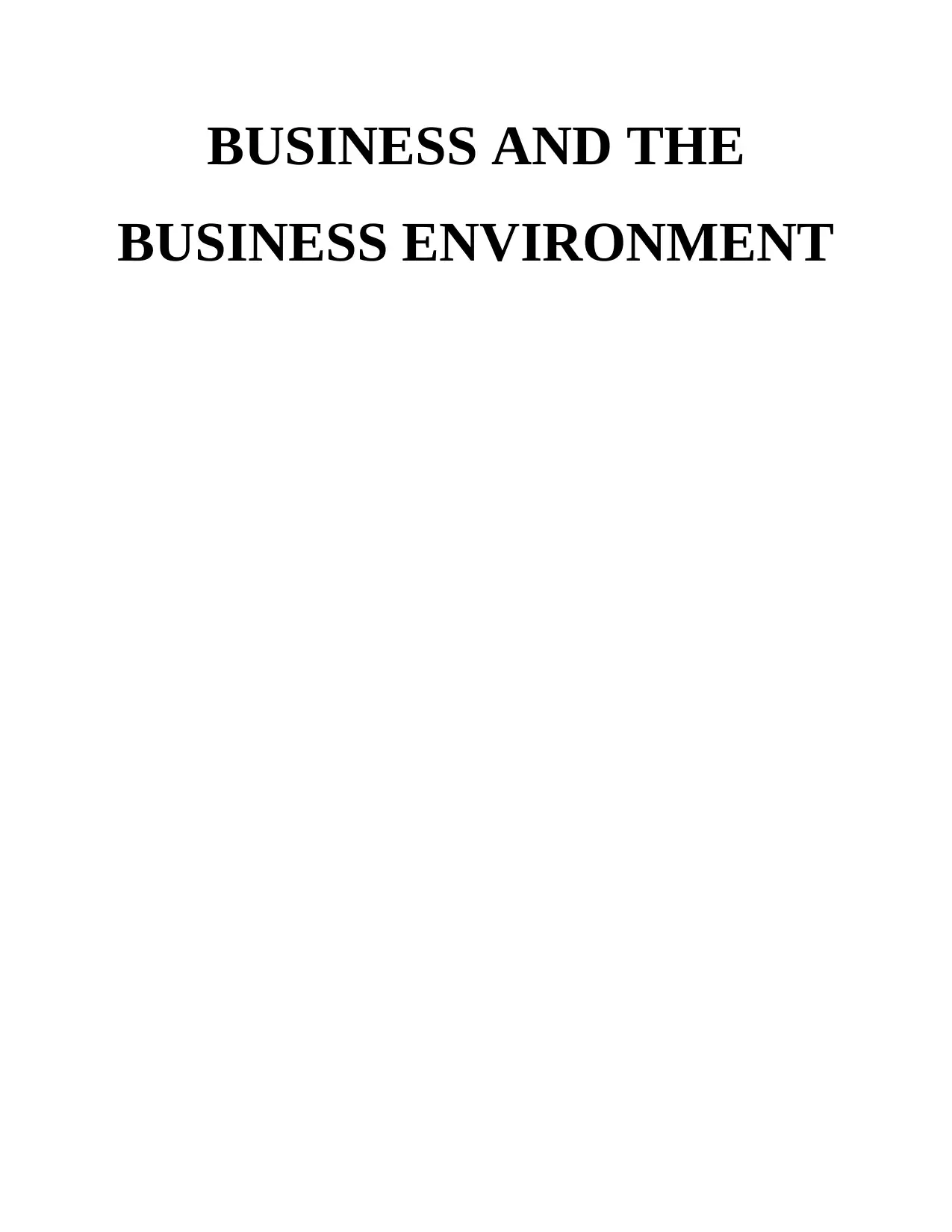
BUSINESS AND THE
BUSINESS ENVIRONMENT
BUSINESS ENVIRONMENT
Paraphrase This Document
Need a fresh take? Get an instant paraphrase of this document with our AI Paraphraser
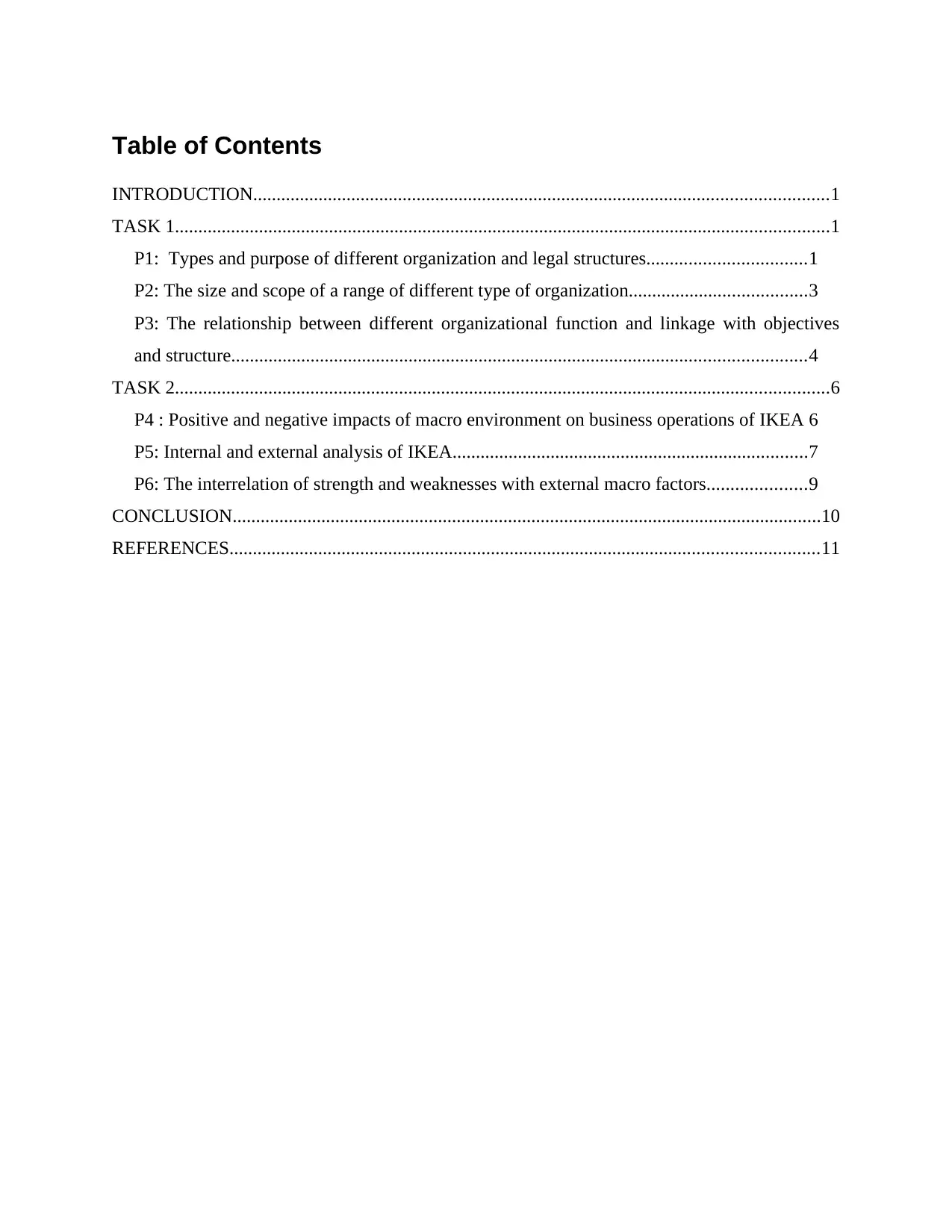
Table of Contents
INTRODUCTION...........................................................................................................................1
TASK 1............................................................................................................................................1
P1: Types and purpose of different organization and legal structures..................................1
P2: The size and scope of a range of different type of organization......................................3
P3: The relationship between different organizational function and linkage with objectives
and structure...........................................................................................................................4
TASK 2............................................................................................................................................6
P4 : Positive and negative impacts of macro environment on business operations of IKEA 6
P5: Internal and external analysis of IKEA............................................................................7
P6: The interrelation of strength and weaknesses with external macro factors.....................9
CONCLUSION..............................................................................................................................10
REFERENCES..............................................................................................................................11
INTRODUCTION...........................................................................................................................1
TASK 1............................................................................................................................................1
P1: Types and purpose of different organization and legal structures..................................1
P2: The size and scope of a range of different type of organization......................................3
P3: The relationship between different organizational function and linkage with objectives
and structure...........................................................................................................................4
TASK 2............................................................................................................................................6
P4 : Positive and negative impacts of macro environment on business operations of IKEA 6
P5: Internal and external analysis of IKEA............................................................................7
P6: The interrelation of strength and weaknesses with external macro factors.....................9
CONCLUSION..............................................................................................................................10
REFERENCES..............................................................................................................................11

INTRODUCTION
Businesses have various purposes that depend on why they were established.
Organizations operate their businesses in an environment which is shaped by various functions
associated with them such as finance, human resource, customer relations, marketing etc. In
addition, the business environment for an organization means all the external as well as internal
factors that have to affect the enterprise activities including Customers, management, employees,
business regulations, supply and demand and so on. The present study is focused on IKEA- a
well-known home furnishing retailer. It always uses customer centric approach and had concern
for people and the environment. In the study, the discussion is made on various dimensions of a
business environment. The types and purpose of an organization and related legal structure are
discussed. The relationship between organizational functions and their linkage with objective
and structure also evaluated. Furthermore, the positive and negative impacts of the macro
environment on IKEA business operations also taken into consideration.
TASK 1
P1: Types and purpose of different organization and legal structures
The following is the description related to purpose of different type of organization:
Private sector organization- The private sector is concerned with all for-profit businesses
which are not owned and operated by the government. It is an integral part of the economy and
run by private groups or individuals. The intention behind the formation of this type of
organization is making the profit (Botha, Kourie and Snyman, 2014). For example, IKEA is
associated with the private sector and dealing as a world's largest furniture retailer, It has
expanded its business in restaurant and kitchen utensils.
Shareholders can have the company's debt. This company can run by the elected BOD by the
debtors or shareholders and this directors are governed by the founder or the chair person of the
organisation. The documents of the IKEA should include all the legal informations about its
headquarters and the registered offices. There will be regular Audit of the books of accounts
which is will bw annually or half yearly.
The below table is describing the objective, mission and vision of private sector organizations:
Objectives Increase the level of profitability
Increase sales volume and level of
1
Businesses have various purposes that depend on why they were established.
Organizations operate their businesses in an environment which is shaped by various functions
associated with them such as finance, human resource, customer relations, marketing etc. In
addition, the business environment for an organization means all the external as well as internal
factors that have to affect the enterprise activities including Customers, management, employees,
business regulations, supply and demand and so on. The present study is focused on IKEA- a
well-known home furnishing retailer. It always uses customer centric approach and had concern
for people and the environment. In the study, the discussion is made on various dimensions of a
business environment. The types and purpose of an organization and related legal structure are
discussed. The relationship between organizational functions and their linkage with objective
and structure also evaluated. Furthermore, the positive and negative impacts of the macro
environment on IKEA business operations also taken into consideration.
TASK 1
P1: Types and purpose of different organization and legal structures
The following is the description related to purpose of different type of organization:
Private sector organization- The private sector is concerned with all for-profit businesses
which are not owned and operated by the government. It is an integral part of the economy and
run by private groups or individuals. The intention behind the formation of this type of
organization is making the profit (Botha, Kourie and Snyman, 2014). For example, IKEA is
associated with the private sector and dealing as a world's largest furniture retailer, It has
expanded its business in restaurant and kitchen utensils.
Shareholders can have the company's debt. This company can run by the elected BOD by the
debtors or shareholders and this directors are governed by the founder or the chair person of the
organisation. The documents of the IKEA should include all the legal informations about its
headquarters and the registered offices. There will be regular Audit of the books of accounts
which is will bw annually or half yearly.
The below table is describing the objective, mission and vision of private sector organizations:
Objectives Increase the level of profitability
Increase sales volume and level of
1
⊘ This is a preview!⊘
Do you want full access?
Subscribe today to unlock all pages.

Trusted by 1+ million students worldwide
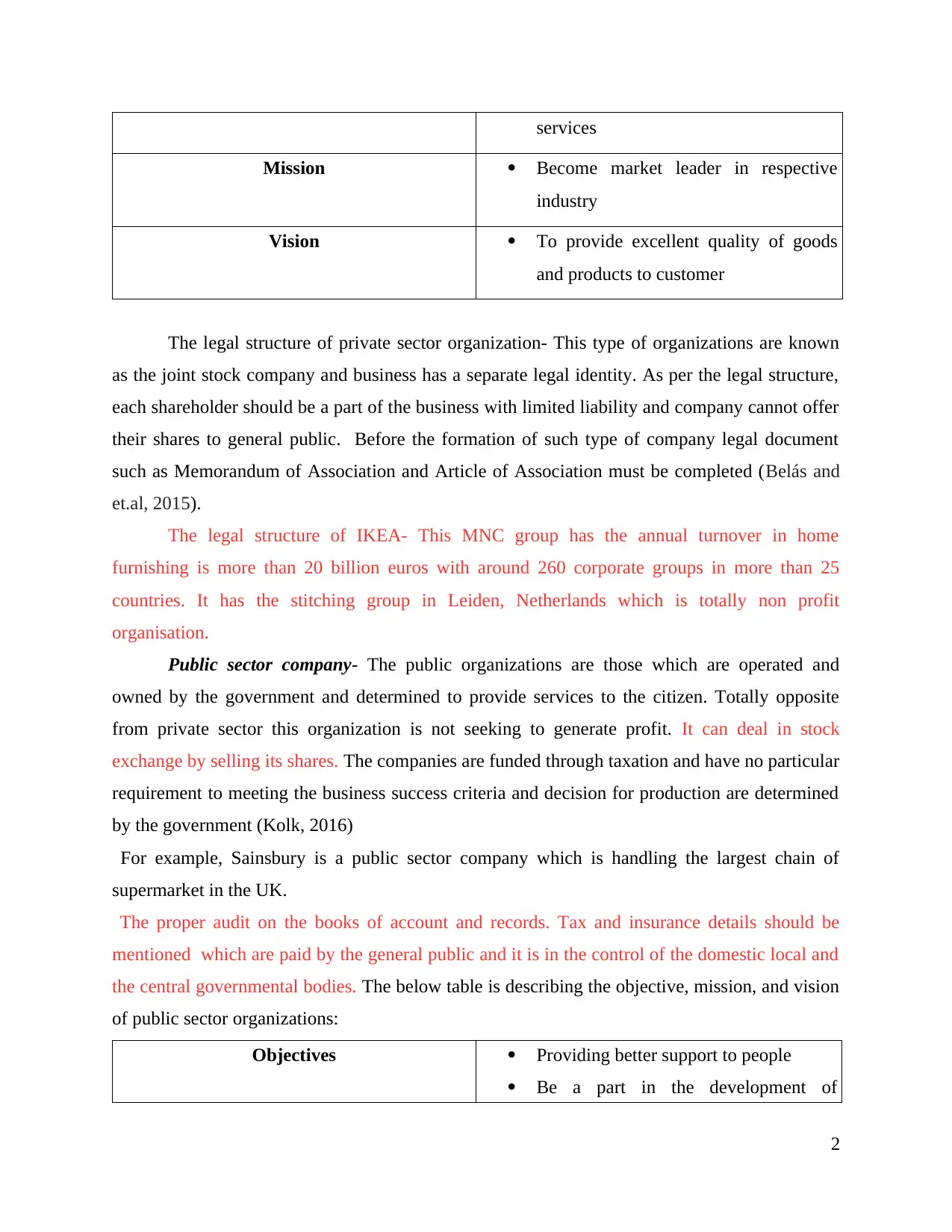
services
Mission Become market leader in respective
industry
Vision To provide excellent quality of goods
and products to customer
The legal structure of private sector organization- This type of organizations are known
as the joint stock company and business has a separate legal identity. As per the legal structure,
each shareholder should be a part of the business with limited liability and company cannot offer
their shares to general public. Before the formation of such type of company legal document
such as Memorandum of Association and Article of Association must be completed (Belás and
et.al, 2015).
The legal structure of IKEA- This MNC group has the annual turnover in home
furnishing is more than 20 billion euros with around 260 corporate groups in more than 25
countries. It has the stitching group in Leiden, Netherlands which is totally non profit
organisation.
Public sector company- The public organizations are those which are operated and
owned by the government and determined to provide services to the citizen. Totally opposite
from private sector this organization is not seeking to generate profit. It can deal in stock
exchange by selling its shares. The companies are funded through taxation and have no particular
requirement to meeting the business success criteria and decision for production are determined
by the government (Kolk, 2016)
For example, Sainsbury is a public sector company which is handling the largest chain of
supermarket in the UK.
The proper audit on the books of account and records. Tax and insurance details should be
mentioned which are paid by the general public and it is in the control of the domestic local and
the central governmental bodies. The below table is describing the objective, mission, and vision
of public sector organizations:
Objectives Providing better support to people
Be a part in the development of
2
Mission Become market leader in respective
industry
Vision To provide excellent quality of goods
and products to customer
The legal structure of private sector organization- This type of organizations are known
as the joint stock company and business has a separate legal identity. As per the legal structure,
each shareholder should be a part of the business with limited liability and company cannot offer
their shares to general public. Before the formation of such type of company legal document
such as Memorandum of Association and Article of Association must be completed (Belás and
et.al, 2015).
The legal structure of IKEA- This MNC group has the annual turnover in home
furnishing is more than 20 billion euros with around 260 corporate groups in more than 25
countries. It has the stitching group in Leiden, Netherlands which is totally non profit
organisation.
Public sector company- The public organizations are those which are operated and
owned by the government and determined to provide services to the citizen. Totally opposite
from private sector this organization is not seeking to generate profit. It can deal in stock
exchange by selling its shares. The companies are funded through taxation and have no particular
requirement to meeting the business success criteria and decision for production are determined
by the government (Kolk, 2016)
For example, Sainsbury is a public sector company which is handling the largest chain of
supermarket in the UK.
The proper audit on the books of account and records. Tax and insurance details should be
mentioned which are paid by the general public and it is in the control of the domestic local and
the central governmental bodies. The below table is describing the objective, mission, and vision
of public sector organizations:
Objectives Providing better support to people
Be a part in the development of
2
Paraphrase This Document
Need a fresh take? Get an instant paraphrase of this document with our AI Paraphraser
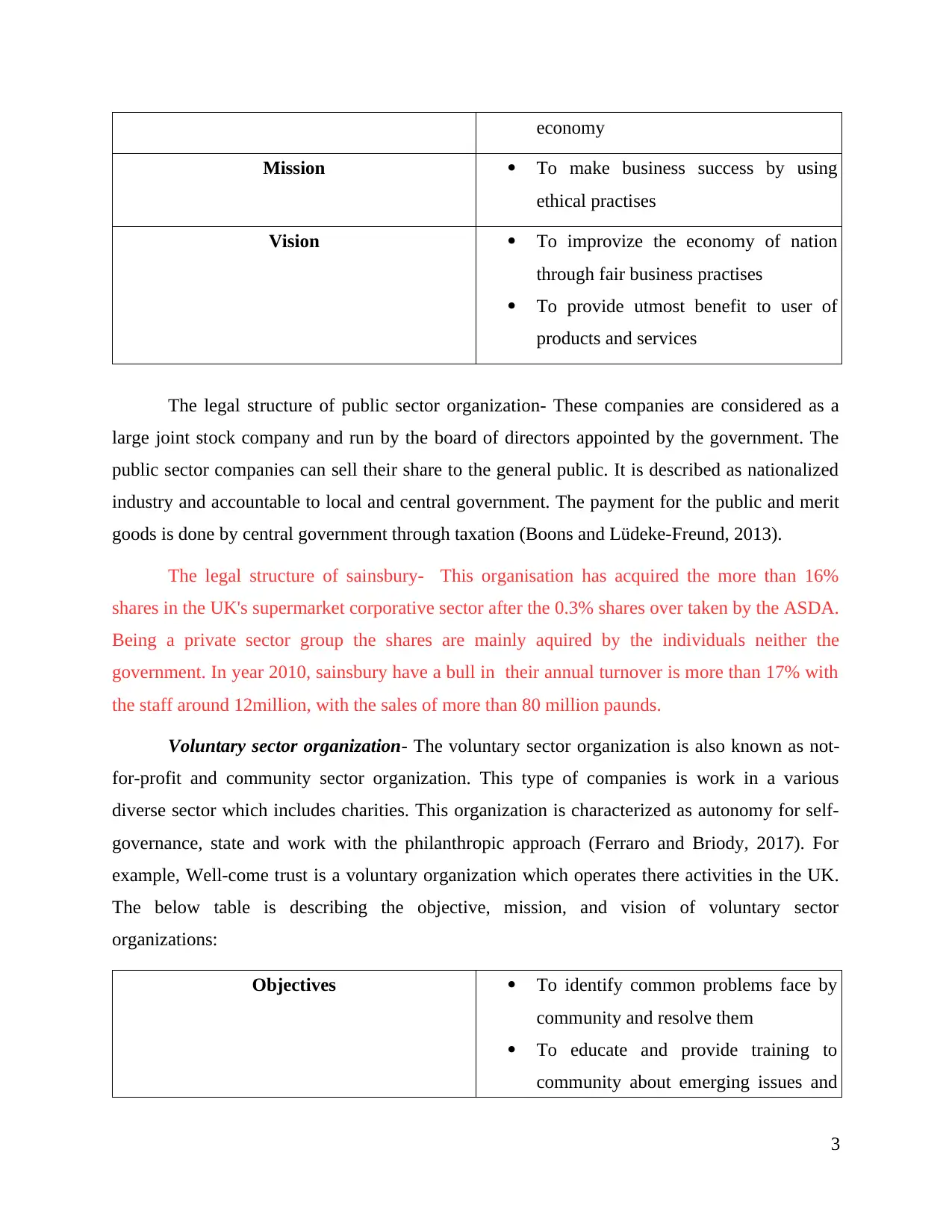
economy
Mission To make business success by using
ethical practises
Vision To improvize the economy of nation
through fair business practises
To provide utmost benefit to user of
products and services
The legal structure of public sector organization- These companies are considered as a
large joint stock company and run by the board of directors appointed by the government. The
public sector companies can sell their share to the general public. It is described as nationalized
industry and accountable to local and central government. The payment for the public and merit
goods is done by central government through taxation (Boons and Lüdeke-Freund, 2013).
The legal structure of sainsbury- This organisation has acquired the more than 16%
shares in the UK's supermarket corporative sector after the 0.3% shares over taken by the ASDA.
Being a private sector group the shares are mainly aquired by the individuals neither the
government. In year 2010, sainsbury have a bull in their annual turnover is more than 17% with
the staff around 12million, with the sales of more than 80 million paunds.
Voluntary sector organization- The voluntary sector organization is also known as not-
for-profit and community sector organization. This type of companies is work in a various
diverse sector which includes charities. This organization is characterized as autonomy for self-
governance, state and work with the philanthropic approach (Ferraro and Briody, 2017). For
example, Well-come trust is a voluntary organization which operates there activities in the UK.
The below table is describing the objective, mission, and vision of voluntary sector
organizations:
Objectives To identify common problems face by
community and resolve them
To educate and provide training to
community about emerging issues and
3
Mission To make business success by using
ethical practises
Vision To improvize the economy of nation
through fair business practises
To provide utmost benefit to user of
products and services
The legal structure of public sector organization- These companies are considered as a
large joint stock company and run by the board of directors appointed by the government. The
public sector companies can sell their share to the general public. It is described as nationalized
industry and accountable to local and central government. The payment for the public and merit
goods is done by central government through taxation (Boons and Lüdeke-Freund, 2013).
The legal structure of sainsbury- This organisation has acquired the more than 16%
shares in the UK's supermarket corporative sector after the 0.3% shares over taken by the ASDA.
Being a private sector group the shares are mainly aquired by the individuals neither the
government. In year 2010, sainsbury have a bull in their annual turnover is more than 17% with
the staff around 12million, with the sales of more than 80 million paunds.
Voluntary sector organization- The voluntary sector organization is also known as not-
for-profit and community sector organization. This type of companies is work in a various
diverse sector which includes charities. This organization is characterized as autonomy for self-
governance, state and work with the philanthropic approach (Ferraro and Briody, 2017). For
example, Well-come trust is a voluntary organization which operates there activities in the UK.
The below table is describing the objective, mission, and vision of voluntary sector
organizations:
Objectives To identify common problems face by
community and resolve them
To educate and provide training to
community about emerging issues and
3
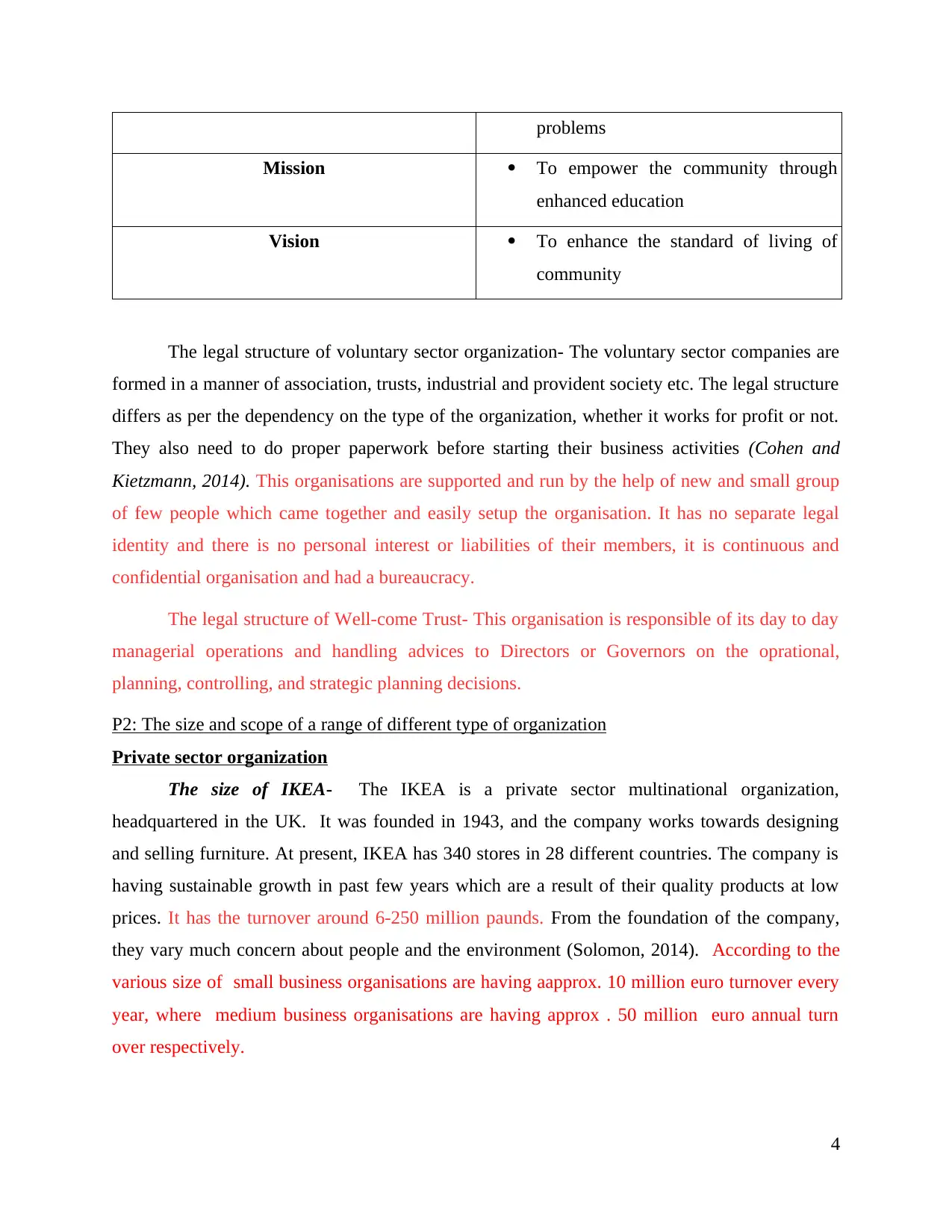
problems
Mission To empower the community through
enhanced education
Vision To enhance the standard of living of
community
The legal structure of voluntary sector organization- The voluntary sector companies are
formed in a manner of association, trusts, industrial and provident society etc. The legal structure
differs as per the dependency on the type of the organization, whether it works for profit or not.
They also need to do proper paperwork before starting their business activities (Cohen and
Kietzmann, 2014). This organisations are supported and run by the help of new and small group
of few people which came together and easily setup the organisation. It has no separate legal
identity and there is no personal interest or liabilities of their members, it is continuous and
confidential organisation and had a bureaucracy.
The legal structure of Well-come Trust- This organisation is responsible of its day to day
managerial operations and handling advices to Directors or Governors on the oprational,
planning, controlling, and strategic planning decisions.
P2: The size and scope of a range of different type of organization
Private sector organization
The size of IKEA- The IKEA is a private sector multinational organization,
headquartered in the UK. It was founded in 1943, and the company works towards designing
and selling furniture. At present, IKEA has 340 stores in 28 different countries. The company is
having sustainable growth in past few years which are a result of their quality products at low
prices. It has the turnover around 6-250 million paunds. From the foundation of the company,
they vary much concern about people and the environment (Solomon, 2014). According to the
various size of small business organisations are having aapprox. 10 million euro turnover every
year, where medium business organisations are having approx . 50 million euro annual turn
over respectively.
4
Mission To empower the community through
enhanced education
Vision To enhance the standard of living of
community
The legal structure of voluntary sector organization- The voluntary sector companies are
formed in a manner of association, trusts, industrial and provident society etc. The legal structure
differs as per the dependency on the type of the organization, whether it works for profit or not.
They also need to do proper paperwork before starting their business activities (Cohen and
Kietzmann, 2014). This organisations are supported and run by the help of new and small group
of few people which came together and easily setup the organisation. It has no separate legal
identity and there is no personal interest or liabilities of their members, it is continuous and
confidential organisation and had a bureaucracy.
The legal structure of Well-come Trust- This organisation is responsible of its day to day
managerial operations and handling advices to Directors or Governors on the oprational,
planning, controlling, and strategic planning decisions.
P2: The size and scope of a range of different type of organization
Private sector organization
The size of IKEA- The IKEA is a private sector multinational organization,
headquartered in the UK. It was founded in 1943, and the company works towards designing
and selling furniture. At present, IKEA has 340 stores in 28 different countries. The company is
having sustainable growth in past few years which are a result of their quality products at low
prices. It has the turnover around 6-250 million paunds. From the foundation of the company,
they vary much concern about people and the environment (Solomon, 2014). According to the
various size of small business organisations are having aapprox. 10 million euro turnover every
year, where medium business organisations are having approx . 50 million euro annual turn
over respectively.
4
⊘ This is a preview!⊘
Do you want full access?
Subscribe today to unlock all pages.

Trusted by 1+ million students worldwide
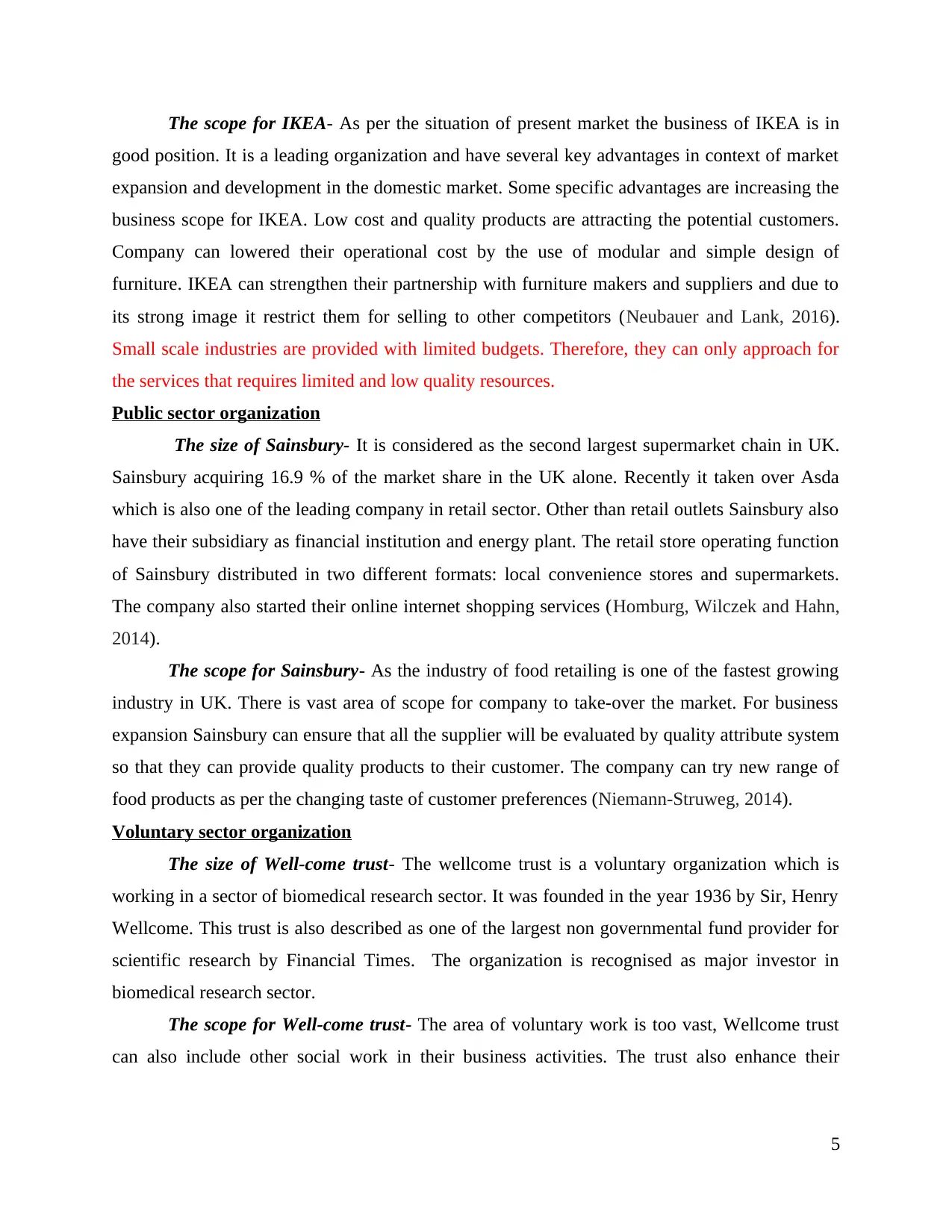
The scope for IKEA- As per the situation of present market the business of IKEA is in
good position. It is a leading organization and have several key advantages in context of market
expansion and development in the domestic market. Some specific advantages are increasing the
business scope for IKEA. Low cost and quality products are attracting the potential customers.
Company can lowered their operational cost by the use of modular and simple design of
furniture. IKEA can strengthen their partnership with furniture makers and suppliers and due to
its strong image it restrict them for selling to other competitors (Neubauer and Lank, 2016).
Small scale industries are provided with limited budgets. Therefore, they can only approach for
the services that requires limited and low quality resources.
Public sector organization
The size of Sainsbury- It is considered as the second largest supermarket chain in UK.
Sainsbury acquiring 16.9 % of the market share in the UK alone. Recently it taken over Asda
which is also one of the leading company in retail sector. Other than retail outlets Sainsbury also
have their subsidiary as financial institution and energy plant. The retail store operating function
of Sainsbury distributed in two different formats: local convenience stores and supermarkets.
The company also started their online internet shopping services (Homburg, Wilczek and Hahn,
2014).
The scope for Sainsbury- As the industry of food retailing is one of the fastest growing
industry in UK. There is vast area of scope for company to take-over the market. For business
expansion Sainsbury can ensure that all the supplier will be evaluated by quality attribute system
so that they can provide quality products to their customer. The company can try new range of
food products as per the changing taste of customer preferences (Niemann-Struweg, 2014).
Voluntary sector organization
The size of Well-come trust- The wellcome trust is a voluntary organization which is
working in a sector of biomedical research sector. It was founded in the year 1936 by Sir, Henry
Wellcome. This trust is also described as one of the largest non governmental fund provider for
scientific research by Financial Times. The organization is recognised as major investor in
biomedical research sector.
The scope for Well-come trust- The area of voluntary work is too vast, Wellcome trust
can also include other social work in their business activities. The trust also enhance their
5
good position. It is a leading organization and have several key advantages in context of market
expansion and development in the domestic market. Some specific advantages are increasing the
business scope for IKEA. Low cost and quality products are attracting the potential customers.
Company can lowered their operational cost by the use of modular and simple design of
furniture. IKEA can strengthen their partnership with furniture makers and suppliers and due to
its strong image it restrict them for selling to other competitors (Neubauer and Lank, 2016).
Small scale industries are provided with limited budgets. Therefore, they can only approach for
the services that requires limited and low quality resources.
Public sector organization
The size of Sainsbury- It is considered as the second largest supermarket chain in UK.
Sainsbury acquiring 16.9 % of the market share in the UK alone. Recently it taken over Asda
which is also one of the leading company in retail sector. Other than retail outlets Sainsbury also
have their subsidiary as financial institution and energy plant. The retail store operating function
of Sainsbury distributed in two different formats: local convenience stores and supermarkets.
The company also started their online internet shopping services (Homburg, Wilczek and Hahn,
2014).
The scope for Sainsbury- As the industry of food retailing is one of the fastest growing
industry in UK. There is vast area of scope for company to take-over the market. For business
expansion Sainsbury can ensure that all the supplier will be evaluated by quality attribute system
so that they can provide quality products to their customer. The company can try new range of
food products as per the changing taste of customer preferences (Niemann-Struweg, 2014).
Voluntary sector organization
The size of Well-come trust- The wellcome trust is a voluntary organization which is
working in a sector of biomedical research sector. It was founded in the year 1936 by Sir, Henry
Wellcome. This trust is also described as one of the largest non governmental fund provider for
scientific research by Financial Times. The organization is recognised as major investor in
biomedical research sector.
The scope for Well-come trust- The area of voluntary work is too vast, Wellcome trust
can also include other social work in their business activities. The trust also enhance their
5
Paraphrase This Document
Need a fresh take? Get an instant paraphrase of this document with our AI Paraphraser
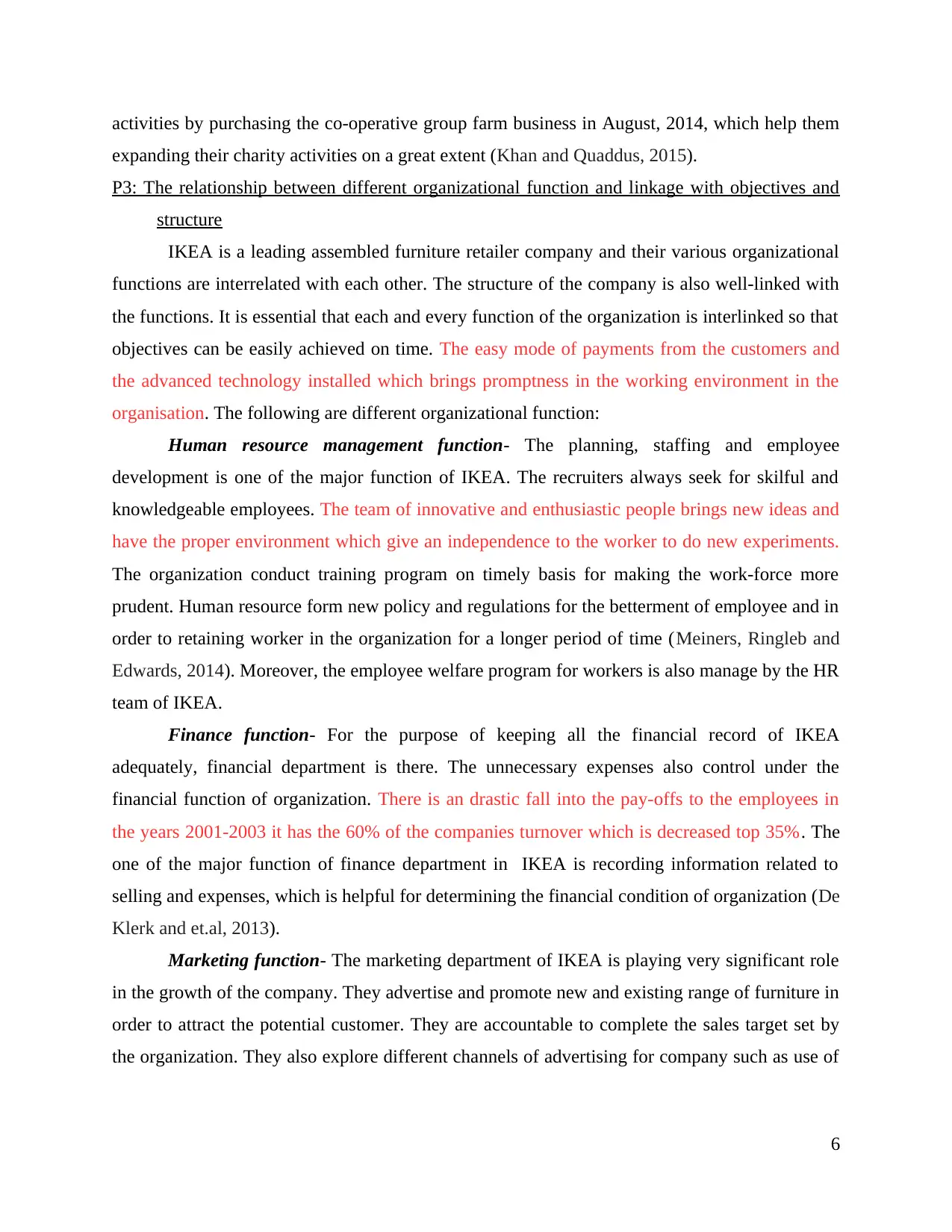
activities by purchasing the co-operative group farm business in August, 2014, which help them
expanding their charity activities on a great extent (Khan and Quaddus, 2015).
P3: The relationship between different organizational function and linkage with objectives and
structure
IKEA is a leading assembled furniture retailer company and their various organizational
functions are interrelated with each other. The structure of the company is also well-linked with
the functions. It is essential that each and every function of the organization is interlinked so that
objectives can be easily achieved on time. The easy mode of payments from the customers and
the advanced technology installed which brings promptness in the working environment in the
organisation. The following are different organizational function:
Human resource management function- The planning, staffing and employee
development is one of the major function of IKEA. The recruiters always seek for skilful and
knowledgeable employees. The team of innovative and enthusiastic people brings new ideas and
have the proper environment which give an independence to the worker to do new experiments.
The organization conduct training program on timely basis for making the work-force more
prudent. Human resource form new policy and regulations for the betterment of employee and in
order to retaining worker in the organization for a longer period of time (Meiners, Ringleb and
Edwards, 2014). Moreover, the employee welfare program for workers is also manage by the HR
team of IKEA.
Finance function- For the purpose of keeping all the financial record of IKEA
adequately, financial department is there. The unnecessary expenses also control under the
financial function of organization. There is an drastic fall into the pay-offs to the employees in
the years 2001-2003 it has the 60% of the companies turnover which is decreased top 35%. The
one of the major function of finance department in IKEA is recording information related to
selling and expenses, which is helpful for determining the financial condition of organization (De
Klerk and et.al, 2013).
Marketing function- The marketing department of IKEA is playing very significant role
in the growth of the company. They advertise and promote new and existing range of furniture in
order to attract the potential customer. They are accountable to complete the sales target set by
the organization. They also explore different channels of advertising for company such as use of
6
expanding their charity activities on a great extent (Khan and Quaddus, 2015).
P3: The relationship between different organizational function and linkage with objectives and
structure
IKEA is a leading assembled furniture retailer company and their various organizational
functions are interrelated with each other. The structure of the company is also well-linked with
the functions. It is essential that each and every function of the organization is interlinked so that
objectives can be easily achieved on time. The easy mode of payments from the customers and
the advanced technology installed which brings promptness in the working environment in the
organisation. The following are different organizational function:
Human resource management function- The planning, staffing and employee
development is one of the major function of IKEA. The recruiters always seek for skilful and
knowledgeable employees. The team of innovative and enthusiastic people brings new ideas and
have the proper environment which give an independence to the worker to do new experiments.
The organization conduct training program on timely basis for making the work-force more
prudent. Human resource form new policy and regulations for the betterment of employee and in
order to retaining worker in the organization for a longer period of time (Meiners, Ringleb and
Edwards, 2014). Moreover, the employee welfare program for workers is also manage by the HR
team of IKEA.
Finance function- For the purpose of keeping all the financial record of IKEA
adequately, financial department is there. The unnecessary expenses also control under the
financial function of organization. There is an drastic fall into the pay-offs to the employees in
the years 2001-2003 it has the 60% of the companies turnover which is decreased top 35%. The
one of the major function of finance department in IKEA is recording information related to
selling and expenses, which is helpful for determining the financial condition of organization (De
Klerk and et.al, 2013).
Marketing function- The marketing department of IKEA is playing very significant role
in the growth of the company. They advertise and promote new and existing range of furniture in
order to attract the potential customer. They are accountable to complete the sales target set by
the organization. They also explore different channels of advertising for company such as use of
6

social media (Aithal, 2016). The company has announced to have the sister heads in several
countries like Finland, Norway etc.
Operational function- The operational function is necessary to determining the objective
and goals of the organization. For maintaining the customer demand IKEA develop their supply
chain and logistic activities. The company believes in providing the innovative and newer ideas
in the development of the customer's desired products with efficiency. The operational function
of the company is also accountable for reducing the wastage and time in manufacturing the
products (Demil and et.al, 2015).
The organizational function of IKEA are totally link to the objective and structure set by
them. The organization adopted matrix structure which is considered as a hybrid structure
including divisional and functional structure. The matrix structure is advantageous for company
as it allows smooth flow of functional and divisional areas of organization.
The functions performed by finance department are interlinked with the company's
objectives. As budget and fund allocation to the employees is important to develop innovative
products for customer. It has the clear vision and business ideas, in which the employees are the
artists and they create a well-designed and quality products that attracts the customers. The
human resource function is interlinked with the divisional activities of company as different
departments require workers with diverse skill-sets. It has the substantial increase in growth of
the company with the long term investments and public shares. The matrix structure define the
level of motivation among employees and how they can work in more effective manner. The
matrix structure is followed by IKEA so that it distributes work to employees in a team and
assigned different set of work under the guidance of specific area managers or team leaders. The
The matrix structure helps in proper allocation of resources including equipments and expertise
of the organisation and build a coordination between projects and products. Employees build the
good communication relationship with the people which speed up the decision process.
TASK 2
P4 : Positive and negative impacts of macro environment on business operations of IKEA
The aim of IKEA is to become profitable and gain success all over the world. For this
purpose, company has to expand their business activities at global level. Therefore, the analysis
7
countries like Finland, Norway etc.
Operational function- The operational function is necessary to determining the objective
and goals of the organization. For maintaining the customer demand IKEA develop their supply
chain and logistic activities. The company believes in providing the innovative and newer ideas
in the development of the customer's desired products with efficiency. The operational function
of the company is also accountable for reducing the wastage and time in manufacturing the
products (Demil and et.al, 2015).
The organizational function of IKEA are totally link to the objective and structure set by
them. The organization adopted matrix structure which is considered as a hybrid structure
including divisional and functional structure. The matrix structure is advantageous for company
as it allows smooth flow of functional and divisional areas of organization.
The functions performed by finance department are interlinked with the company's
objectives. As budget and fund allocation to the employees is important to develop innovative
products for customer. It has the clear vision and business ideas, in which the employees are the
artists and they create a well-designed and quality products that attracts the customers. The
human resource function is interlinked with the divisional activities of company as different
departments require workers with diverse skill-sets. It has the substantial increase in growth of
the company with the long term investments and public shares. The matrix structure define the
level of motivation among employees and how they can work in more effective manner. The
matrix structure is followed by IKEA so that it distributes work to employees in a team and
assigned different set of work under the guidance of specific area managers or team leaders. The
The matrix structure helps in proper allocation of resources including equipments and expertise
of the organisation and build a coordination between projects and products. Employees build the
good communication relationship with the people which speed up the decision process.
TASK 2
P4 : Positive and negative impacts of macro environment on business operations of IKEA
The aim of IKEA is to become profitable and gain success all over the world. For this
purpose, company has to expand their business activities at global level. Therefore, the analysis
7
⊘ This is a preview!⊘
Do you want full access?
Subscribe today to unlock all pages.

Trusted by 1+ million students worldwide
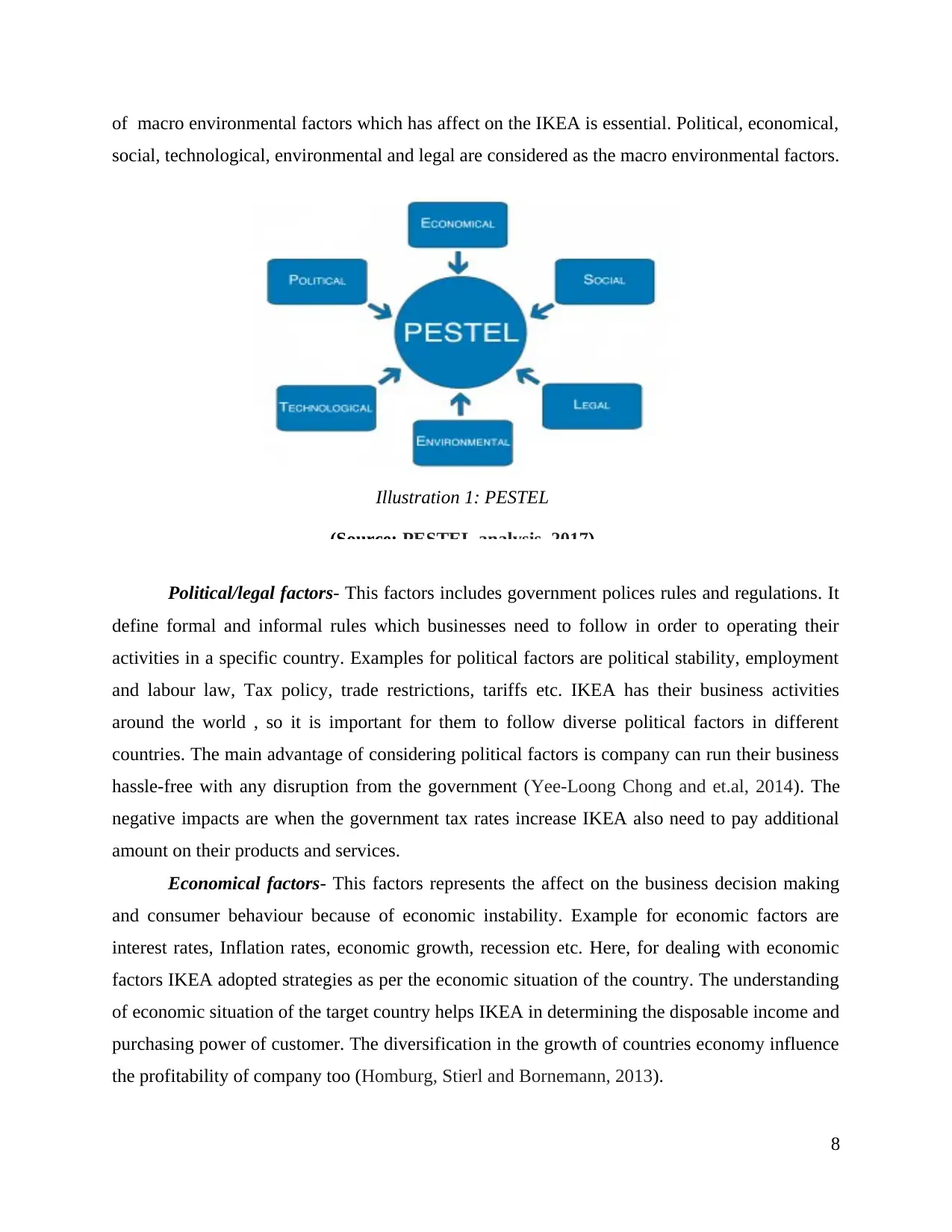
of macro environmental factors which has affect on the IKEA is essential. Political, economical,
social, technological, environmental and legal are considered as the macro environmental factors.
Political/legal factors- This factors includes government polices rules and regulations. It
define formal and informal rules which businesses need to follow in order to operating their
activities in a specific country. Examples for political factors are political stability, employment
and labour law, Tax policy, trade restrictions, tariffs etc. IKEA has their business activities
around the world , so it is important for them to follow diverse political factors in different
countries. The main advantage of considering political factors is company can run their business
hassle-free with any disruption from the government (Yee-Loong Chong and et.al, 2014). The
negative impacts are when the government tax rates increase IKEA also need to pay additional
amount on their products and services.
Economical factors- This factors represents the affect on the business decision making
and consumer behaviour because of economic instability. Example for economic factors are
interest rates, Inflation rates, economic growth, recession etc. Here, for dealing with economic
factors IKEA adopted strategies as per the economic situation of the country. The understanding
of economic situation of the target country helps IKEA in determining the disposable income and
purchasing power of customer. The diversification in the growth of countries economy influence
the profitability of company too (Homburg, Stierl and Bornemann, 2013).
8
Illustration 1: PESTEL
(Source: PESTEL analysis, 2017)
social, technological, environmental and legal are considered as the macro environmental factors.
Political/legal factors- This factors includes government polices rules and regulations. It
define formal and informal rules which businesses need to follow in order to operating their
activities in a specific country. Examples for political factors are political stability, employment
and labour law, Tax policy, trade restrictions, tariffs etc. IKEA has their business activities
around the world , so it is important for them to follow diverse political factors in different
countries. The main advantage of considering political factors is company can run their business
hassle-free with any disruption from the government (Yee-Loong Chong and et.al, 2014). The
negative impacts are when the government tax rates increase IKEA also need to pay additional
amount on their products and services.
Economical factors- This factors represents the affect on the business decision making
and consumer behaviour because of economic instability. Example for economic factors are
interest rates, Inflation rates, economic growth, recession etc. Here, for dealing with economic
factors IKEA adopted strategies as per the economic situation of the country. The understanding
of economic situation of the target country helps IKEA in determining the disposable income and
purchasing power of customer. The diversification in the growth of countries economy influence
the profitability of company too (Homburg, Stierl and Bornemann, 2013).
8
Illustration 1: PESTEL
(Source: PESTEL analysis, 2017)
Paraphrase This Document
Need a fresh take? Get an instant paraphrase of this document with our AI Paraphraser
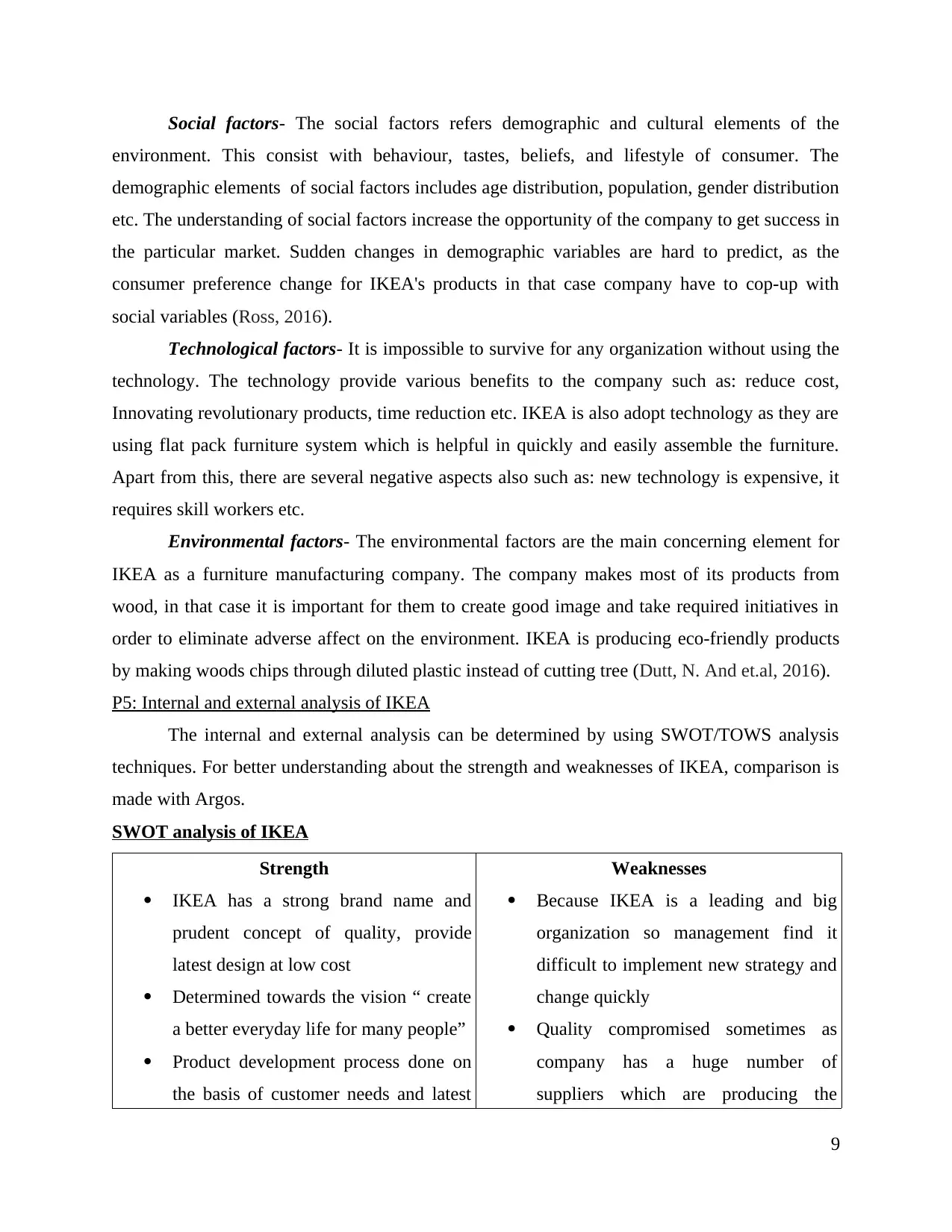
Social factors- The social factors refers demographic and cultural elements of the
environment. This consist with behaviour, tastes, beliefs, and lifestyle of consumer. The
demographic elements of social factors includes age distribution, population, gender distribution
etc. The understanding of social factors increase the opportunity of the company to get success in
the particular market. Sudden changes in demographic variables are hard to predict, as the
consumer preference change for IKEA's products in that case company have to cop-up with
social variables (Ross, 2016).
Technological factors- It is impossible to survive for any organization without using the
technology. The technology provide various benefits to the company such as: reduce cost,
Innovating revolutionary products, time reduction etc. IKEA is also adopt technology as they are
using flat pack furniture system which is helpful in quickly and easily assemble the furniture.
Apart from this, there are several negative aspects also such as: new technology is expensive, it
requires skill workers etc.
Environmental factors- The environmental factors are the main concerning element for
IKEA as a furniture manufacturing company. The company makes most of its products from
wood, in that case it is important for them to create good image and take required initiatives in
order to eliminate adverse affect on the environment. IKEA is producing eco-friendly products
by making woods chips through diluted plastic instead of cutting tree (Dutt, N. And et.al, 2016).
P5: Internal and external analysis of IKEA
The internal and external analysis can be determined by using SWOT/TOWS analysis
techniques. For better understanding about the strength and weaknesses of IKEA, comparison is
made with Argos.
SWOT analysis of IKEA
Strength
IKEA has a strong brand name and
prudent concept of quality, provide
latest design at low cost
Determined towards the vision “ create
a better everyday life for many people”
Product development process done on
the basis of customer needs and latest
Weaknesses
Because IKEA is a leading and big
organization so management find it
difficult to implement new strategy and
change quickly
Quality compromised sometimes as
company has a huge number of
suppliers which are producing the
9
environment. This consist with behaviour, tastes, beliefs, and lifestyle of consumer. The
demographic elements of social factors includes age distribution, population, gender distribution
etc. The understanding of social factors increase the opportunity of the company to get success in
the particular market. Sudden changes in demographic variables are hard to predict, as the
consumer preference change for IKEA's products in that case company have to cop-up with
social variables (Ross, 2016).
Technological factors- It is impossible to survive for any organization without using the
technology. The technology provide various benefits to the company such as: reduce cost,
Innovating revolutionary products, time reduction etc. IKEA is also adopt technology as they are
using flat pack furniture system which is helpful in quickly and easily assemble the furniture.
Apart from this, there are several negative aspects also such as: new technology is expensive, it
requires skill workers etc.
Environmental factors- The environmental factors are the main concerning element for
IKEA as a furniture manufacturing company. The company makes most of its products from
wood, in that case it is important for them to create good image and take required initiatives in
order to eliminate adverse affect on the environment. IKEA is producing eco-friendly products
by making woods chips through diluted plastic instead of cutting tree (Dutt, N. And et.al, 2016).
P5: Internal and external analysis of IKEA
The internal and external analysis can be determined by using SWOT/TOWS analysis
techniques. For better understanding about the strength and weaknesses of IKEA, comparison is
made with Argos.
SWOT analysis of IKEA
Strength
IKEA has a strong brand name and
prudent concept of quality, provide
latest design at low cost
Determined towards the vision “ create
a better everyday life for many people”
Product development process done on
the basis of customer needs and latest
Weaknesses
Because IKEA is a leading and big
organization so management find it
difficult to implement new strategy and
change quickly
Quality compromised sometimes as
company has a huge number of
suppliers which are producing the
9
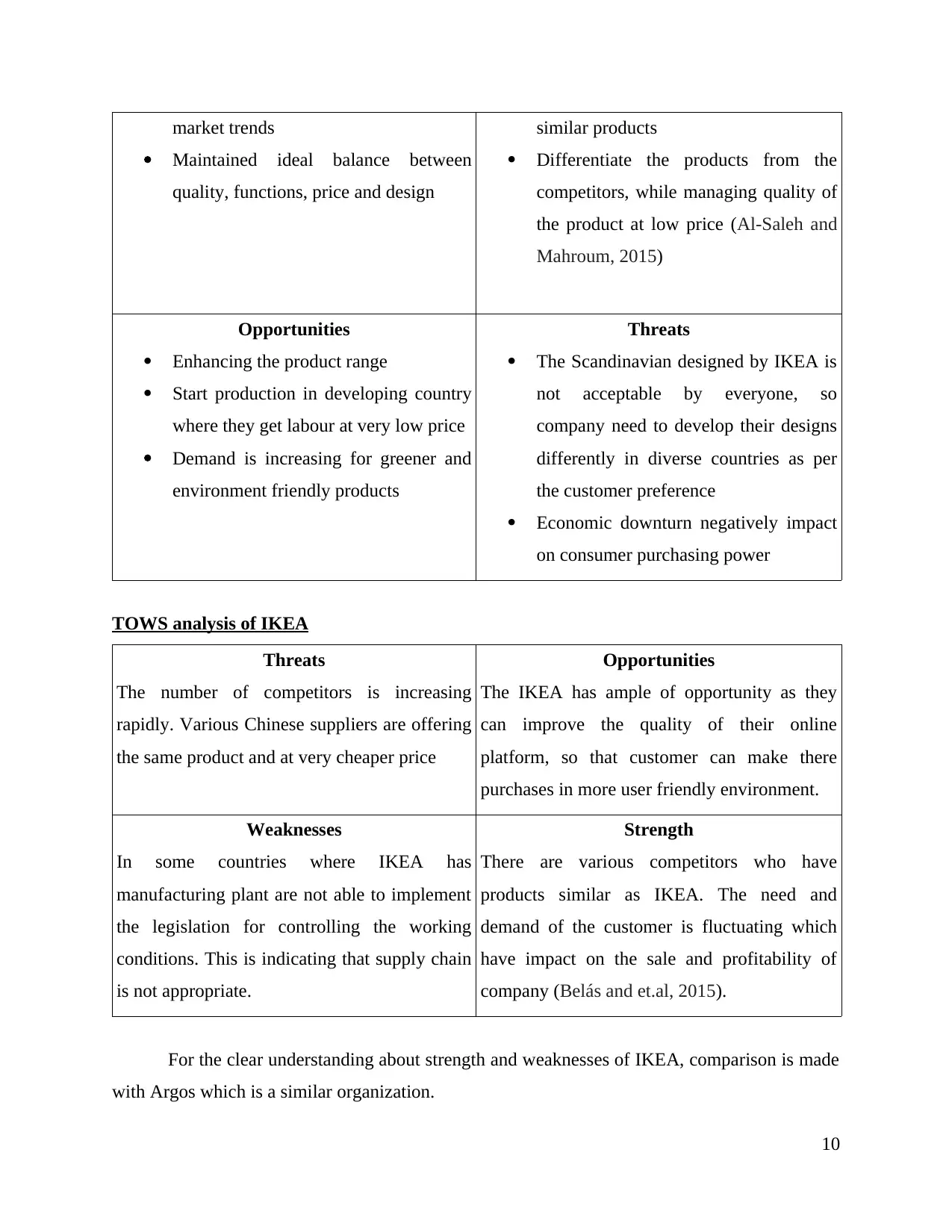
market trends
Maintained ideal balance between
quality, functions, price and design
similar products
Differentiate the products from the
competitors, while managing quality of
the product at low price (Al-Saleh and
Mahroum, 2015)
Opportunities
Enhancing the product range
Start production in developing country
where they get labour at very low price
Demand is increasing for greener and
environment friendly products
Threats
The Scandinavian designed by IKEA is
not acceptable by everyone, so
company need to develop their designs
differently in diverse countries as per
the customer preference
Economic downturn negatively impact
on consumer purchasing power
TOWS analysis of IKEA
Threats
The number of competitors is increasing
rapidly. Various Chinese suppliers are offering
the same product and at very cheaper price
Opportunities
The IKEA has ample of opportunity as they
can improve the quality of their online
platform, so that customer can make there
purchases in more user friendly environment.
Weaknesses
In some countries where IKEA has
manufacturing plant are not able to implement
the legislation for controlling the working
conditions. This is indicating that supply chain
is not appropriate.
Strength
There are various competitors who have
products similar as IKEA. The need and
demand of the customer is fluctuating which
have impact on the sale and profitability of
company (Belás and et.al, 2015).
For the clear understanding about strength and weaknesses of IKEA, comparison is made
with Argos which is a similar organization.
10
Maintained ideal balance between
quality, functions, price and design
similar products
Differentiate the products from the
competitors, while managing quality of
the product at low price (Al-Saleh and
Mahroum, 2015)
Opportunities
Enhancing the product range
Start production in developing country
where they get labour at very low price
Demand is increasing for greener and
environment friendly products
Threats
The Scandinavian designed by IKEA is
not acceptable by everyone, so
company need to develop their designs
differently in diverse countries as per
the customer preference
Economic downturn negatively impact
on consumer purchasing power
TOWS analysis of IKEA
Threats
The number of competitors is increasing
rapidly. Various Chinese suppliers are offering
the same product and at very cheaper price
Opportunities
The IKEA has ample of opportunity as they
can improve the quality of their online
platform, so that customer can make there
purchases in more user friendly environment.
Weaknesses
In some countries where IKEA has
manufacturing plant are not able to implement
the legislation for controlling the working
conditions. This is indicating that supply chain
is not appropriate.
Strength
There are various competitors who have
products similar as IKEA. The need and
demand of the customer is fluctuating which
have impact on the sale and profitability of
company (Belás and et.al, 2015).
For the clear understanding about strength and weaknesses of IKEA, comparison is made
with Argos which is a similar organization.
10
⊘ This is a preview!⊘
Do you want full access?
Subscribe today to unlock all pages.

Trusted by 1+ million students worldwide
1 out of 17
Related Documents
Your All-in-One AI-Powered Toolkit for Academic Success.
+13062052269
info@desklib.com
Available 24*7 on WhatsApp / Email
![[object Object]](/_next/static/media/star-bottom.7253800d.svg)
Unlock your academic potential
Copyright © 2020–2025 A2Z Services. All Rights Reserved. Developed and managed by ZUCOL.





